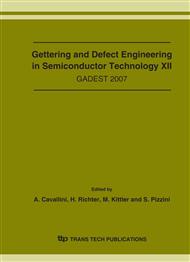[1]
Sentaurus Process User Guide, version Y-2006. 06 (2006).
Google Scholar
[2]
K. Suzuki, Y. Kataoka, S. Nagayama, C. W. Magee, T. H. Büyüklimanli, and T. Nagayama, IEEE Transactions on electron devices, Vol. 54 (2007), p.262.
DOI: 10.1109/ted.2006.888676
Google Scholar
[3]
A. Nylandsted Larsen, P. E. Andersen, P. Gaiduk, and K. Kyllesbech Larsen, Materials Science and Engineering B, Vol. 4 (1989), p.107.
DOI: 10.1016/0921-5107(89)90225-0
Google Scholar
[4]
A. Nylandsted Larsen, K. Kyllesbech Larsen, P. E. Andersen, and B. G. Svensson, J. Appl. Phys., Vol. 73 (1993), p.691.
Google Scholar
[5]
J. Murota, E. Arai, K. Kobayashi, and K. Kudo, J. Appl. Phys., Vol. 50 (1979), p.804.
Google Scholar
[6]
B. J. Masters and J. M. Fairfield, J. Appl. Phys., Vol. 40 (1969), p.2390.
Google Scholar
[7]
R.B. Fair, Concentration profiles of diffused dopants in silicon, in Impurity Doping Processes In Silicon, edited by F.F.Y. Wang North-Holland Publishing Company (1981).
DOI: 10.1016/b978-0-444-86095-8.50012-4
Google Scholar
[8]
K. Suzuki, FUJITSU Sci. Tech. J., Vol. 39 (2003), p.138.
Google Scholar
[9]
P. Pichler, Intrinsic Point defects, Impurities, and Their Diffusion in Silicon, Springer-Verlag (2004).
Google Scholar
[10]
D. Nobili, S. Solmi, A. Parisini, M. Derdour, A. Armigliato, and L. Moro, Phys. Rev. B, Vol. 49 (1994), p.2477.
DOI: 10.1103/physrevb.49.2477
Google Scholar
[11]
S. Solmi and D. Nobili, J. Appl. Phys. Vol. 83 (1998), p.2484.
Google Scholar
[12]
A. Nylandsted Larsen, B. Christensen, and S. Y. Shiryaev, J. Appl. Phys., Vol. 71 (1992), p.4854.
Google Scholar
[13]
D. Nobili, S. Solmi, M. Merli, and J. Shao, Journal of The Electrochemical Society, Vol. 146 (1999), p.4246.
Google Scholar
[14]
D. Nobili, S. Solmi, and J. Shao, J. Appl. Phys., Vol. 90 (2001), p.101.
Google Scholar
[15]
A. Parisini, D. Nobili, A. Armigliato, M. Derdour, L. Moro, and S. Solmi, , Applied Physics A, Vol. 54 (1992), p.221.
DOI: 10.1007/bf00323840
Google Scholar
[16]
F. Iacona, V. Raineri, and F. La Via, Physical Review B, Vol. 58 (1998), p.10990.
Google Scholar
[17]
R. Kasnavi, Y. Sun, R. Mo, P. Pianetta, P. B. Griffin and J. D. Plummer, J. Appl. Phys. Vol. 87 (2000), p.2255.
Google Scholar
[18]
M. Ferri, S. Solmi, A. Parisini M. Bersani, D. Giubertoni, and M. Barozzi, J. Appl. Phys., Vol. 99 (2006), p.113508.
DOI: 10.1063/1.2200587
Google Scholar
[19]
C. Steen, P. Pichler, H. Ryssel, L. Pei, G. Duscher, M. Werner, J. van der Berg, W. Windl, to be published at Mater. Res. Symp. Proc., Vol. 994 (2007).
DOI: 10.1557/proc-0994-f08-02
Google Scholar
[20]
F. Lau, L. Mader, C. Mazure, Ch. Werner, and M. Orlowski, Appl. Phys. A, Vol. 49 (1989), p.671.
Google Scholar
[21]
C. Steen, A. Martinez-Limia, P. Pichler, H. Ryssel, L. Pei, G. Duscher, W. Windl, to be published at the Proceedings of the 37th European Solid-State Device Research Conference, ESSDERC (2007).
DOI: 10.1109/essderc.2007.4430929
Google Scholar
[22]
B. J. Pawlaka, R. Duffy, T. Janssens, W. Vandervorst, K. Maex, A. J. Smith, N. E. B. Cowern, T. Dao, and Y. Tamminga, Applied Physics Letters, Vol. 87 (2005), p.031915.
DOI: 10.1063/1.1997276
Google Scholar
[23]
C. Tsamis, D. Skarlatos, G. BenAssayag, A. Claverie, W. Lerch, and V. Valamontes, Applied Physics Letters, Vol. 87 (2005), p.201903.
DOI: 10.1063/1.2130397
Google Scholar
[24]
V. Krishnamoorthy, K. Moller,K. S. Jones, D. Venables, J. Jackson, and L. Rubin, J. Appl. Phys., Vol. 84 (1998), p.5997.
Google Scholar
[25]
S. Solmi, M. Ferri, M. Bersani, D. Giubertoni, V. Soncini, J. Appl. Phys,. Vol. 94 (2003), p.4950.
DOI: 10.1063/1.1609640
Google Scholar
[26]
M. Dalponte, H. Boudinov, L. V. Goncharova, D. Starodub, E. Garfunkel, and T. Gustafsson, J. Appl. Phys., Vol. 96 (2004), p.7388.
Google Scholar
[27]
W. Lerch, S. Paul, J. Chan, S. McCoy, J. Gelpey, F. Cristiano, F. Severac, P. F. Fazzini, D. Bolze, P. Pichler, A. Martinez, A. Mineji, and S. Shishiguchi, International Workshop on Junction Technology, IWJT '07 (2007).
DOI: 10.1109/iwjt.2007.4279966
Google Scholar


